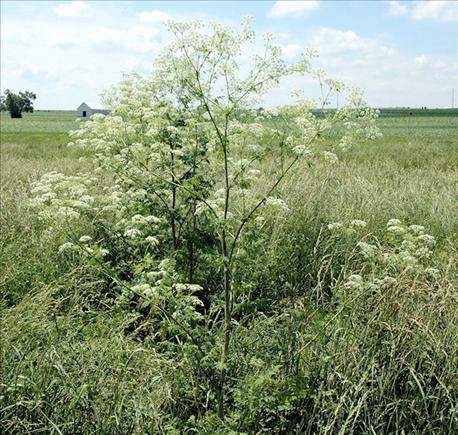Socrates met his end because his enemies figured out how to poison him. They used poison hemlock. Unfortunately, thousands of years later, it's appearing more frequently, and it could be a threat to your livestock.
Related: Keep Your Animals Away From Poison Hemlock
Robbie Zupancic, livestock grazing specialist in southeast Indiana for the Natural Resources Conservation Service, starts off almost every talk this summer with a warning about poison hemlock – no matter what his real subject matter is for the talk.
He often brings a specimen of the plant along, and also some poison hemlock found in hay.
"We want people to be aware that it is out there and they need to watch for it," he says.
Pure poison: Robbie Zupancic displays a poison hemlock plant. While not the best specimen, he notes it has the signature characteristic: white flowers.
Indeed, after Zupancic gave a talk to cattlemen at a field day recently, many of them spotted poison hemlock in road ditches and pastures when they went on a pasture tour at the host farm later. It's a matter of knowing what it looks like, and being ready to identify it, he says,
The risk might actually be greater if it winds up in hay for livestock, Zupancic says. Cattle and sheep are both susceptible to the toxin. If poison hemlock is growing in pasture fields, animals may not eat it. However, if it winds up in a handful of hay inside a bale, the animal is likely to eat it without detecting it.
Once ingested, the toxin moves through the system. It can cause a wide range of symptoms in livestock, including reproductive problems and abortions, all the way to death, Zupancic notes. The impact depends upon the concentration of the weed the animal consumes, and how much toxin goes into its system.
Related: Wet weather brings out poison hemlock

Green poison hemlock - University of Kentucky Extension
Unfortunately, the best time to control poison hemlock with herbicides is in the fall or very early spring, Zupancic says. Once you spot it now the best thing you can do is make sure animals don't have access to it, and that you don't roll it up into hay.
See a description and more resources on poison hemlock from the University of Kentucky Extension and Purdue University Extension.
About the Author(s)
You May Also Like




